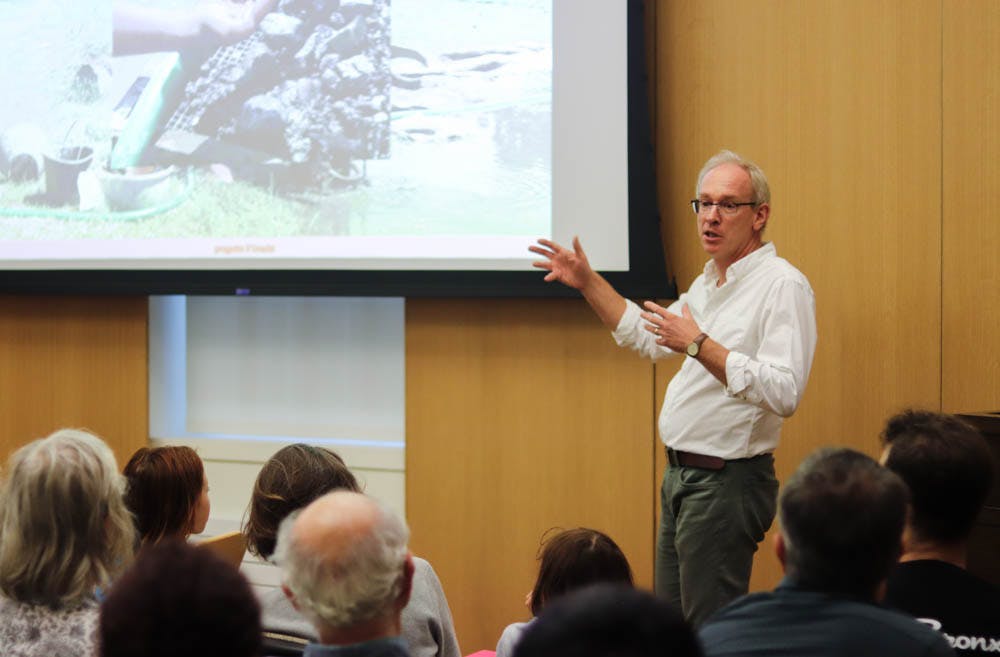Six University professors presented findings from their summer archaeological fieldwork to students, faculty and other community members yesterday at the Joukowsky Institute for Archaeology. Audience members scribbled along in notebooks, captivated by the professors’ latest discoveries in Jordan, France, Greece, Turkey, Mexico, Guatemala and Italy.
Peter van Dommelen, professor of archaeology and professor of anthropology, emceed the event, which started by examining Van Dommelen’s research project. Van Dommelen spent his summer in S’Urachi on the west coast of the island of Sardinia, Italy. He and his team spent two weeks pickaxing, shoveling and wheelbarrowing topsoil out of their excavation areas. Their labor was worthwhile, according to van Dommelen, who said his team discovered preserved fruits and a piece of tree trunk with bark on it completely caked in mud. At one point during the summer, President Christina Paxson P ’19 visited the
site. In a photo Dommelen projected onto the wall, Paxson “sort of looked interestingly at all the mud,” he joked.
Sheila Bonde, professor of archaeology and the ancient world and professor of history of art and architecture, studied a monastery in Tiron, France. Her site was originally overgrown with a dense patch of stinging nettles that were almost as tall as she was. The site also featured frequent guest appearances by miniature goats who loved to eat Bonde’s notebook, she said. Bonde and her team surveyed the monastery’s interior and exterior in addition to excavating remains of decorated floor tiles, medieval pottery, fragments of stained glass and pieces of sculpture. “That one,” Bonde pointed out, “is an angel’s wing. We dug up an angel’s wing!”
Next, audience members were transported to Mexico and Guatemala to learn about the studies of Andrew Scherer, associate professor of anthropology and associate professor archaeology and the ancient world. Scherer worked on two sides of the Usumacinta River in Mexico, trying to form a better understanding of two ancient Mayan kingdoms, Piedras Negras and Yaxchilan. These kingdoms were “more enemies than allies,” Scherer said. His team excavated an obsidian workshop and skeletons, among other findings. Scherer himself spent a month weaving drones through trees to document the site rapidly.
Yannis Hamilakis, professor of archaeology and professor of modern Greek studies, spent his summer on the island of Lesbos between Turkey and Greece. His more modern project examined “food procurement, preparation and consumption” in the context of migration.
Felipe Rojas Silva, assistant professor of archaeology and the ancient world and Egyptology and Assyriology, worked together with Laurel Bestock, associate professor of archaeology and the ancient world and Egyptology and Assyriology, and associate professor of history of art and architecture. In order to research the terracing systems of Petra, Jordan, they dug six trenches, which allowed them to analyze the landscape. Bestock trialed a new digital recording system that allowed her team to go paperless in the field. She used an iPad to document artifacts and imagery, raving during her presentation about the ease with which the program organized materials. In the future, Rojas would like to examine a whole watershed from the top of the Shara mountains to understand how to control water from the summit to the base.
Each of the professors noted the collaboration that aided their efforts this summer. They worked with undergraduate and graduate students from the University, students from local universities and other professors and partners. Many of the audience members had been on the archaeological teams themselves.
Other audience members stuck around after the presentation to ask questions and enjoy refreshments.
An earlier version of this article stated that S’Urachi is an island off the west coast of Sardinia. In fact, S’Urachi is on the west coast of the island of Sardinia. An earlier version of this article also misspelled the name of the Shara mountains. In addition, the article previously stated that Yannis Hamilakis, professor of archaeology and professor of modern Greek studies, excavated skeletons while in Lesbos. In fact, Hamilakis excavated a skeleton on a different archaeological project in mainland Greece. The sentence has been removed. The Herald regrets the errors.





